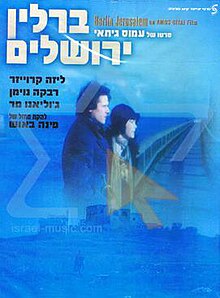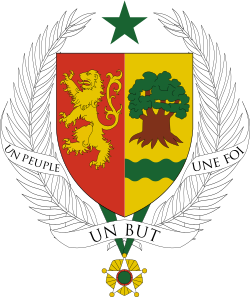베를린-제르웨스트
Berlin-Jerusalem| 베를린-제르웨스트 | |
|---|---|
 베를린-예루살렘 DVD 커버. | |
| 연출자 | 아모스 기타이 |
| 생산자 | 마렉 로젠바움 |
| 주연 | |
| 음악 기준 | 마르쿠스 슈톡하우젠 사이먼 스톡하우젠 |
| 배포자 | 파셋 멀티미디어 |
출시일 |
|
러닝타임 | 89분 |
| 나라들. |
|
| 언어들 | |
베를린-제르웨스트(Hebre: ברליןןןן,,,,, tr.베를린 예루살레이임)은 1989년 아모스 기타이 감독이 연출한 89분 분량의 영국-더치-프랑스-이스라엘-이탈리아어-이탈리아어 독립 지하극적 실험예술 영화다.
시놉시스
이 영화는 1930년대의 두 여성에 대한 이야기를 다룬다.첫째, 독일의 표현주의 시인인 엘라스커 슐러(리사 크뢰저)는 예루살렘으로 떠나기 전 베를린에서 나치즘의 부상을 관찰한다.두 번째, 영화에서 타니아로 불리는 러시아 마야 쇼차트(리브카 노이만)는 이스라엘의 한 공동체에 정착한다.
생산
The film was produced by Marek Rozenbaum, includes the artistic contributions of Pina Bausch and was inspired by the paintings of George Grosz, was financed by the Italian public television, Nederlandse Omroep Stichting, La Sept, Department for Digital, Culture, Media and Sport’s UK Government Investments’s Channel Four Television Corporation’s Film4 Productions, the Centre national du cinéma et de l’image animée, and Le Volcan, was distributed by Facets Multi-Media, was shot by Henri Alekan and Nurith Aviv, was edited by Marco Melani, Antoine Bonfanti, Michel Klochendler, and Luc Barnier, was cast by Levia Hon, and also stars inter alia마르쿠스 스톡하우젠(시몬 스톡하우젠과 함께 득점하기도 했다), 버논 도브체프, 베로니카 라즈르, 베르나르 아이젠시츠, 요시 그라베르 훌리아노 메르-카미스, 마크 이바니르, 케렌 모어, 오리 레비 오하드 샤하르.[1][2][3][4][5]
리셉션
The film was screened at the 46th Venice International Film Festival during September 1989 (where it won several awards and was nominated for the Golden Lion), at the 1990 International Istanbul Film Festival/!f İstanbul Uluslararası Bağımsız Filmler Festivali (where it also won several awards) and International Film Festival Rotterdam, at the1989년 9월 13일 1989년 토론토 국제영화제, 1992년 2월 22일 제42회 베를린 국제영화제, 1998년 상파울루 국제영화제.저널리스트 다니엘 워스는 "이 영화는 미니멀하지만 그럼에도 불구하고 황홀하다"[6]고 말했다.이 영화는 이스라엘에서 개봉되었는데, 1990년 12월 7일 누리스 샤니의 샤니 필름과 텔아비브 시네마테크가 (1990년 3월 14일 프랑스, 1991년 12월 13일 네덜란드)과 함께 2005년 DVD 박스 세트의 일부로 일반에 개봉하였다.[7]
참조
- ^ Kronish, Amy W.; Safirman, Costel (May 2003). Israeli Film: A Reference Guid e. Reference Guides to the World’s Cinema. Westport, Connecticut and London: Greenwood Publishing Group and Praeger. pp. 32–33. ISBN 9780313321443. OCLC 845524002. Retrieved 30 September 2018.
- ^ Gross, Natan (1991). הסרט העברי – פרקים בתולדות הראינוע והקולנוע בישראל: 1896–1991 [The Hebrew Film – Chapters in the Annals of Silent and Sound Cinema in Israel: 1896–1991] (in Hebrew). Jerusalem: Natan and Yaacov Gross. p. 446. OCLC 27221790. Retrieved 30 September 2018.
- ^ Handler, Deborah (2004). ייצוגה של ירושלים בקולנוע הישראלי [Representations of Jerusalem in Israeli Cinema] (PDF). Tallelei Orot (in Hebrew). Vol. 11. Orot Israel College of Education. pp. 276, 281. Retrieved 30 September 2018.
- ^ 코프먼, 데보라, Plotkin, 재니스, Orenstein, 레나, eds.(1991년)."Berlin-Jerusalem". 가이드 필름스 Featured에 유대인 영화제에서.버클리, 캘리포니아:유대인 영화제. 페이지의 주 15.OCLC 25527469.309월 2018년 Retrieved.Plotkin, 재니스, Libresco, 캐롤라인, Feiger, 조쉬, eds:에서.(1996년)Reprinted.독립적인 유대인 영화:A자원 가이드(3판).캘리포니아 샌 프란시스코:샌 프란시스코 유대인 영화제. 우편 46.아이 에스비엔 9780965068802.온라인 컴퓨터 도서관 센터 36119531.309월 2018년 Retrieved.
- ^ Schweitzer, Ariel. עמוס גיתאי [Amos Gitai]. Cinema of Israel (in Hebrew). Retrieved 8 March 2019.
- ^ Warth, Daniel (14 December 1990). תפיסות מנוגדות [Conflicting Visions] (PDF). Ha’ir (in Hebrew). Tel Aviv-Yafo. Retrieved 30 September 2018.
- ^ Gitai, Amos (2005). ברלין ירושלים [Berlin-Jerusalem] (DVD) (in French, German, and Hebrew). Ramat HaSharon: Globus United King Films. OCLC 920667873.
원천
- Nassi, Tigal (31 May 2008). יום ירושלים בערוצי הטלוויזיה [Jerusalem Day on the Television Channels]. Haaretz (in Hebrew). Retrieved 30 September 2018.
- Willemen, 폴(1992년 3월)."Bangkok-Bahrain Berlin-Jerusalem에:아모스 Gitai의 Editing".화면.Vol33,1.를 대신하여 서명함. 14–26.309월 2018년 Retrieved.Willemen, 폴,(1993년):에 Reprinted."Bangkok-Bahrain–Berlin-Jerusalem".그 필름스 아모스 Gitai의:몽타주.BFI영화 클래식.런던:영국 영화 협회. 니코틴산. 5–16.아이 에스비엔 9780851704166.OCLC 882549941.
- Schultz, Deanne (December 2006). Filmography of World History. Westport, Connecticut and London: Greenwood Publishing Group and Praeger. pp. 15–16. ISBN 9780313326813. OCLC 717252153.
- Schwartz, Oshra (16 October 1989). גלות וציונות [Exile and Zionism] (PDF). Davar (in Hebrew). Tel Aviv-Yafo: Society of Workers. Retrieved 30 September 2018.
- Israel, Yael (7 December 1990). אנשים לא מוכנים שיהרסו להם את החלום [People Will Not Consent Into Having Their Dreams Shattered (Part I)] (PDF). Al HaMishmar (in Hebrew). Tel Aviv-Yafo: Hashomer Hatzair and Mapam. p. 18. Retrieved 30 September 2018.
- Israel, Yael (7 December 1990). אנשים לא מוכנים שיהרסו להם את החלום [People Will Not Consent Into Having Their Dreams Shattered (Part II)] (PDF). Al HaMishmar (in Hebrew). Tel Aviv-Yafo: Hashomer Hatzair and Mapam. p. 19. Retrieved 30 September 2018.
- Klein, Uri. כיוון הרוח [The Direction of the Wind] (PDF). Haaretz (in Hebrew). p. 38. Retrieved 30 September 2018.
- 버라이어티 필름 리뷰,
- Milne, Tom; Pym, John, eds. (2007). Time Out Film Guide (15th ed.). London, Gütersloh, and New York: Penguin Books and Time Out. p. 96. ISBN 9781904978602. OCLC 441060357.
- Toubiana, Serge; Piégay, Baptiste (2003). Exils et territoires: Le cinéma d'Amos Gitaï [Exiles and Territories: The Cinema of Amos Gitai] (in French). London, New York, Strasbourg, Paris: Cahiers du cinéma, Arte éd. pp. 144ff. ISBN 9782866422257. OCLC 237852120.
- Coureau, Didier (June 2009). "Esthétique de la traversée: Paysagéité et nomadisme, Berlin Jérusalem et Kedma" [The Aesthetics of Crossing: Landscape and Nomadism, Berlin-Jerusalem and Kedma]. Cinémaction: Revue trimestrielle (in French). Vol. 131, no. Amos Gitaï, entre terre et exil [Amos Gitai, Between Land and Exile]. Condé-sur-Noireau: Éditions Charles Corlet. pp. 20–32. Retrieved 1 October 2018.
- Privett, Ray (2009). "Série Exil partie 1, Esther et Berlin Jérusalem" [Exile Series Part 1, Esther and Berlin-Jerusalem]. Cinémaction: Revue trimestrielle (in French). Vol. 131, no. Amos Gitaï, entre terre et exil [Amos Gitai, Between Land and Exile]. Condé-sur-Noireau: Éditions Charles Corlet. pp. 52–57. Retrieved 1 October 2018.
- Farassino, Alberto (29 March 1989). "Addio Israele terra d'utopie" [Farewell Israel, the Land of Uopia]. La Repubblica (in Italian). Retrieved 1 October 2018.
- "Vita fra spari e rovine" [Life Between Shots and Ruins]. La Repubblica (in Italian). 21 August 1991. Retrieved 1 October 2018.
- Schnitzer, Meir (1994). הקולנוע הישראלי: כל העובדות, כל העלילות, כל הבמאים וגם ביקורות [Israeli Cinema: All Facts, All Plots, All Directors, and All Critiques] (in Hebrew). Or Yehuda and Jerusalem: Kinneret Zmora-Bitan, Dvir, Israel Film Archive, Israel Film Institute. p. 320. ISBN 9789652863782. OCLC 31817606.
- Willemen, Paul, ed. (1993). The Films of Amos Gitai: A Montage. BFI Film Classics. London: British Film Institute. pp. 42ff. ISBN 9780851704166. OCLC 882549941.



